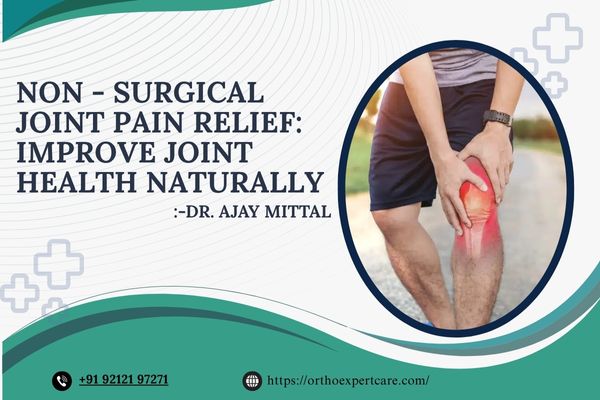Healthy joints are essential for mobility, flexibility, and overall quality of life. With the rise in joint problems due to sedentary lifestyles, aging, and repetitive strain, many people are looking for effective ways to reduce discomfort and improve joint function. Non-Surgical Joint Pain Relief provides a safe, natural, and evidence-based approach to maintain strong, pain-free joints.
Under the guidance of experts like Dr. Ajay Mittal, patients can adopt strategies that enhance joint strength, increase flexibility, and prevent further degeneration. This approach focuses on long-term joint health, prioritizing safety, and minimizing the risks associated with invasive procedures.
Why Non-Surgical Joint Pain Relief Matters
Surgery is often considered a last resort for joint problems due to risks, longer recovery periods, and higher costs. Non-Surgical Joint Pain Relief provides an effective alternative by focusing on:
- Reducing pain naturally
- Improving joint function
- Strengthening muscles around the joints
- Enhancing mobility and flexibility
Dr. Ajay Mittal emphasizes that early intervention through personalized non-surgical joint care can significantly improve mobility and quality of life. Patients often experience faster recovery and may avoid surgical procedures altogether.
Effective Strategies for Non-Surgical Joint Pain Relief
A comprehensive non-surgical joint pain relief plan combines safe exercises, lifestyle adjustments, and low-impact activities to support joint health. Key strategies include:
1. Targeted Strengthening Exercises
Strengthening the muscles surrounding joints reduces stress on the joints and provides natural support. This helps prevent further damage and minimizes discomfort.
2. Flexibility and Mobility Work
Gentle stretching and mobility exercises improve the range of motion, reduce stiffness, and enhance overall joint performance.
3. Low-Impact Activities
Walking, swimming, cycling, and water exercises improve cardiovascular health without stressing joints. These activities are ideal for knees, hips, and shoulders.
4. Balance and Coordination Practices
Exercises that enhance balance, like standing on one leg or using stability tools, improve stability and prevent injuries.
Dr. Mittal notes that combining these strategies consistently is key to long-lasting results and effective non-invasive joint care.
The Role of Nutrition in Supporting Joint Health
Proper nutrition plays a vital role in non-surgical joint pain relief by providing essential nutrients that support joint health and reduce inflammation. Foods rich in omega-3 fatty acids, calcium, vitamin D, and antioxidants help strengthen cartilage, improve bone density, and promote overall joint function. Combining a balanced diet with regular exercises enhances mobility, reduces discomfort, and supports long-term joint wellness naturally.
Practical Exercises to Support Joint Health
Here are some safe exercises that can help maintain joint strength and mobility:
- Knee Support: Leg raises, mini-squats, and hamstring curls improve stability and reduce discomfort.
- Shoulder Flexibility: Arm circles, wall slides, and resistance band movements enhance mobility.
- Hip Strengthening: Bridges, side leg raises, and lunges support hip stability and prevent degeneration.
- Elbow and Wrist Care: Bicep curls, wrist stretches, and forearm exercises enhance function and reduce discomfort.
Even a few minutes of these exercises daily can help achieve pain-free joints naturally.
Lifestyle Adjustments for Joint Health
Successful non-surgical joint pain relief goes beyond exercises and includes adopting habits that protect and nourish your joints:
- Stay active throughout the day and avoid prolonged sitting
- Maintain proper posture while sitting, standing, or lifting objects
- Eat a balanced diet rich in calcium, vitamin D, and omega-3 fatty acids
- Stay hydrated and ensure quality sleep for recovery
Dr. Ajay Mittal emphasizes that combining these lifestyle strategies with targeted exercises maximizes results and prevents future joint problems.
FAQs About Non-Surgical Joint Pain Relief
Q1: What is the best way to relieve joint pain naturally?
A: A combination of strengthening exercises, mobility routines, low-impact activities, and lifestyle adjustments tailored to your joint condition is highly effective.
Q2: How long does it take to see results?
A: Most patients notice improvements in pain, flexibility, and strength within 4–6 weeks of consistent practice.
Q3: Can non-surgical methods prevent surgery?
A: Yes, early adoption of non-surgical joint pain relief strategies can often delay or eliminate the need for surgical intervention.
Q4: Are there any risks with non-surgical joint care?
A: Risks are minimal. Mild soreness may occur initially, but these approaches are generally safe and low-risk.
Q5: How often should I do exercises for joint health?
A: Most specialists recommend 3–5 guided sessions per week, with daily home exercises for best results.
Conclusion
Non-Surgical Joint Pain Relief offers a safe, effective way to maintain stronger, flexible, and pain-free joints. By combining targeted exercises, expert guidance from professionals like Dr. Ajay Mittal, and healthy lifestyle adjustments, patients can achieve lasting improvements in mobility and overall quality of life.
If you are looking for a natural, non-invasive solution for joint discomfort, Consult Dr. Ajay Mittal today to explore a personalized plan for joint health and pain-free living.
